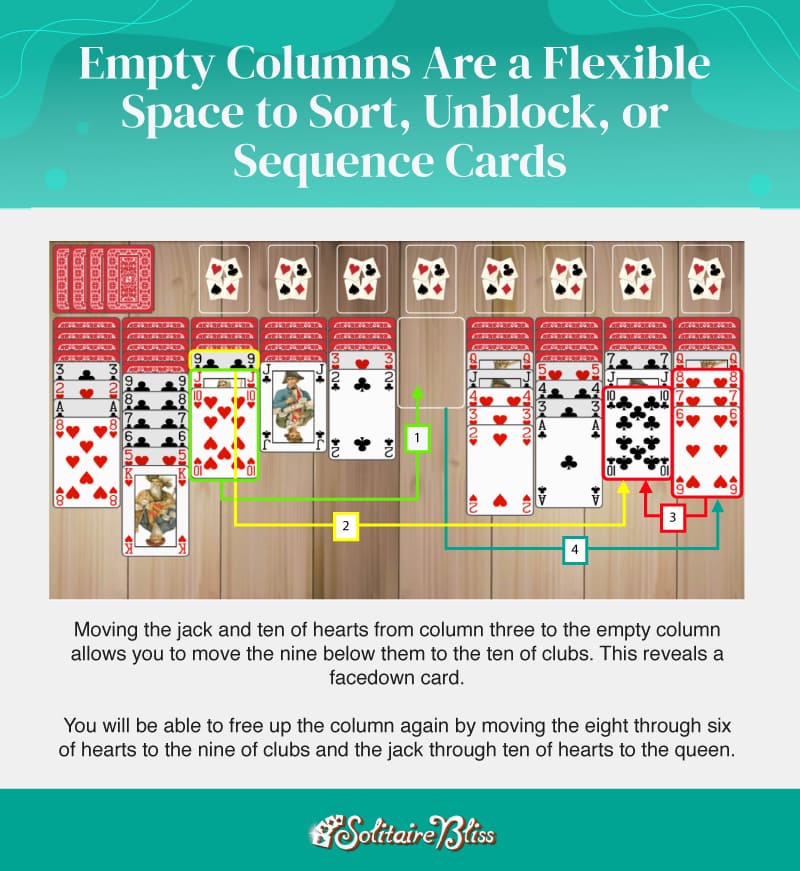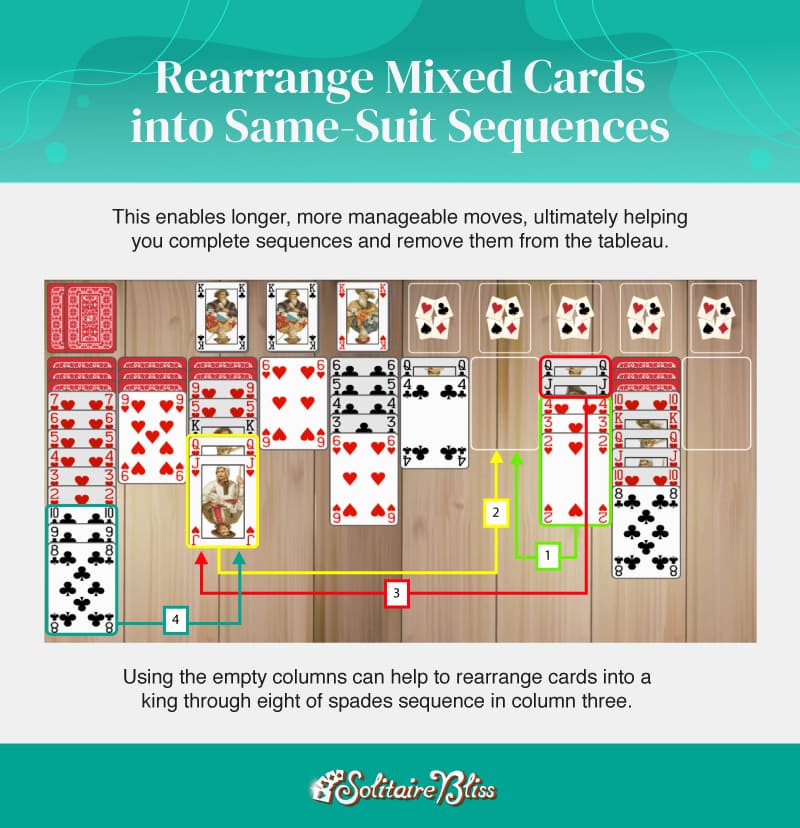Spider Solitaire Strategies & Tips
Whether you've just begun to play Spider Solitaire or you're an experienced pro wanting to advance to new variations of this popular card game, learning Spider Solitaire strategies will help you level up your win rate.
To win the game of Spider Solitaire, you'll need to build sequences of the same suit from ace to king in the tableau. Completed sequences can be moved to foundation piles and once you build all eight sequences, you win the game.
Even though you can only move same-suit sequences around the tableau or to the foundation piles, you're able to sequence any cards that descend in rank. For example, you could play a nine of diamonds on a ten of clubs, but you can't move that sequence into another column. In this example, only the nine is playable. If you need to remind yourself how to play, check out our how-to-play Spider Solitaire guide.
You can also play several different versions of Spider Solitaire that vary by difficulty, ranging from 1 Suit (beginner), 2 Suits (intermediate), and 4 Suits (advanced). By utilizing the following Spider Solitaire strategies, you can learn how to win and advance to a more challenging level.
1. Start by Building Sequences of the Same Suit.
You can only move sequences of the same suit (also called natural builds) from column to column within the tableau, and must create complete same-suit sequences (king to ace) in order to move cards to foundation piles. So to get closer to winning the game, you should prioritize building same-suit sequences.
Spider Solitaire 1 Suit only allows you to build sequences of one suit, while Spider Solitaire 2 Suits and 4 Suits allow you to build sequences of different suits.
Think carefully about how building mixed-suit sequences may block future moves in the tableau. There's more flexibility early in the game, but you should always prioritize building same-suit sequences when given the option.

2. Prioritize Moves That Will Reveal Facedown Cards.
There are 44 facedown cards in the tableau, but you can only play face-up cards. To flip over facedown cards, you have to move a card or sequence off of a facedown card to gain a new card to play.
Revealing these cards is essential to winning the game since you need them to complete sequences and move cards into foundation piles. New faceup cards also help increase the available moves on the tableau and can keep you from getting stuck.
While you can draw from the stockpile if you get stuck, the stockpile only has 50 cards, which means you can only draw from it five times before it is depleted. If you empty the stockpile and are left with mostly hidden cards on the tableau, you will limit the number of moves you can make and risk losing the game. It's best to avoid using the stockpile too much early in the game, and instead, work on overturning those facedown cards.

3. Focus on Moves That Will Have a Waterfall Effect.
Instead of making the first move you see, take time to assess the entire tableau and figure out what move might yield you the most consecutive possible moves.
Moving a card from the bottom of a column might free up a card or sequence that could also be moved or empty spaces can be utilized to free up blocked cards that you need to use to complete a sequence.
Look out for multiples of the same card on the tableau, as moving one of those cards might give you more additional moves than the other. See the visual above for an example.
4. Build Mixed Sequences on Higher Ranks.
Early in the game, it may be helpful to sequence cards regardless of suit to reveal more facedown cards. However, do so strategically and only once you've exhausted all the same-suit options.
When playing Spider Solitaire 2 Suits or 4 Suits, it's important to maximize the number of moves you can make by starting mixed-suit sequences on higher ranking cards. This allows you to make longer runs and avoid blocking cards on the tableau.
As a simple example, if you have a six of hearts, five of hearts, and four of clubs available at the bottom of different columns in the tableau, you'll want to move the five on top of the six first. If you don't, the five will be blocked by the four because you can't move sequences of different suits.
Be sure to do this strategically when you're out of all other options, or you might block yourself from being able to make same-suit sequences. You can keep moves open by creating “wild” columns, where you move cards of any suit. Then, you can organize the rest of your columns by the same suit so you won't get stuck later.

5. Use the stockpile as a Last Resort.
If you use the stockpile too much, you run the risk of burying important cards you might need. This makes it harder for you to reach them, as you must rearrange more to build sequences and reveal those facedown cards.
Be selective about the amount of times you use the stockpile. You only have 50 cards in the stockpile, and you can only draw from it five times. So only use the stockpile as a last resort when you are sure that you have run out of moves to make.
6. Prioritize Moves That Will Empty Columns.
Vacant columns will allow you to rearrange cards in the tableau, free up cards that are stuck, and reveal facedown cards. By prioritizing emptying columns, you can give yourself more future moves which might help you win the game.
Say you have a nine and eight of spades that cover a ten of hearts, along with a nine to six of hearts at the bottom of another column. By using a free column, you can move the nine and eight there, which frees up the ten for the sequence of hearts in the other column.
Just because you have a clear column does not mean you need to use it right away, as keeping it available for use may help you in the future.

7. Choose the Cards You Move to an Empty Column Wisely.
If you do have an empty column, make sure you pay attention to the card you first place on it. While you will want to place higher cards in a column, you should avoid placing a king there if a queen is not readily available to start building a sequence. The king can't be moved on top of other cards and free the column up again, meaning you may waste the flexibility an empty column provides.
The only exception to this is if a king is blocking a large sequence of cards, in which case you may want to move it up into the empty column.
You should also avoid moving lower cards into the empty column as that will give you fewer cards to play on it in the future. For example, if you move a two into the column, you will only be able to play an ace on top of it. However, if you place a ten there, you'll be able to put at least nine more cards on top.
8. Rearrange Mixed Cards to Create Same-Suit Sequences.
As mentioned before, building mixed-suit sequences may be helpful early on in the game, but you will want to start rearranging your cards into same-suit sequences at some point. Let's say you have a sequence of eight through five of clubs placed on a nine of hearts. Then, you deal a nine of clubs from the stockpile. You can rearrange the tableau, moving the eight through five sequence to the nine of the clubs.
This is a critical strategy, as rearranging mixed-suit sequences into same-suit sequences allows you to make more advantageous moves in the future. As you progress through the game, the moves possible become more limited, so being able to adapt from mixed-suit to same-suit sequences is key.

9. Undo Moves If Necessary.
Don't hesitate to use the undo button, as it could make the difference between you winning or losing the game. You might reveal a better facedown card after two moves, or you might regret having used the stockpile.
For example, you may find yourself in a situation where two threes of hearts cover facedown cards in two different columns, with a four of hearts in another column. You may decide to try both to see which card can further your gameplay. There's no shame in clicking the undo button, so don't avoid using it.
Ready to try these winning strategies? You don't have to dust off your playing cards or find enough table space because you can play Solitaire online for free on Solitaire Bliss! Test out these Spider Solitaire tips with an easy Spider Solitaire 1 Suit game or check out your advanced skills with Spider Solitaire 4 Suits.
Back to the Homepage


